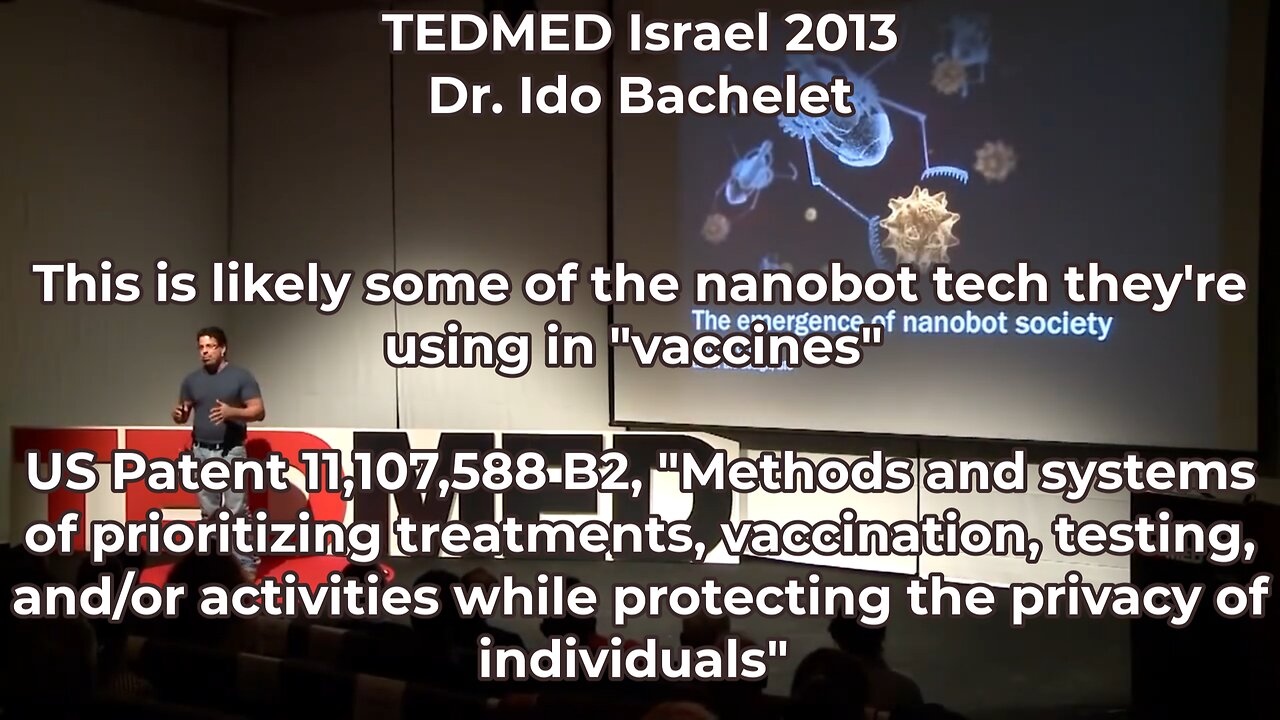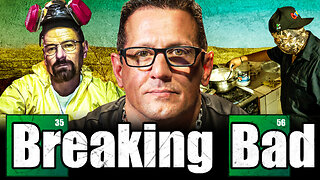Premium Only Content

TEDMED Israel 2013 - Dr. Ido Bachelet - The emergence of nanobot society
SUMMARY
Introduction to Technology (00:01 - 00:28): The speaker introduces real technologies being demonstrated and shares a personal story about his daughter Dana, who has a leg condition that requires surgeries, highlighting her fears before operations.
Future Medical Procedure (00:56 - 01:27): Visualizes a future scenario where a syringe filled with millions of tiny robots will perform surgeries autonomously, allowing Dana to relax during the procedure while the robots remove damaged tissue and promote healing.
Nanobot Development (01:53 - 02:59): Describes the advanced nanobots developed in his lab, emphasizing their size and capabilities, and explains how they can interact with the body to carry out medical tasks safely and effectively.
DNA Origami and Robot Functionality (06:08 - 07:57): Discusses the use of DNA origami to construct nanobots capable of carrying drugs and other molecules, which can be programmed to activate in response to specific signals from the body.
Swarm Behavior and Coordination (10:32 - 12:48): Explains the potential of engineered swarm behavior in nanobots, allowing them to mimic natural organisms and coordinate activities for complex procedures, such as forming bridges across tissue gaps or timing drug releases.
Biocomputing and Control (14:06 - 16:47): Explores the computing capabilities of nanobots, through which they can process information and interact with their environment, and discusses using external controls (like a joystick) to activate these nanobots remotely.
Future Prospects (17:17 - 18:06): Concludes with a vision for the future use of these nanobots in human medicine, emphasizing their ability to navigate biological systems and manipulate cellular communication for treating diseases effectively.
TRANSCRIPT
(00:01) Thank you very much. So one word of notice before we begin, all the technologies you're going to see here now are real. And with that said, I'd like to first tell you the story about this little girl named Dana. She's very special for me because she's my daughter. And Dana was born with a leg condition requiring frequent surgeries, like this one she had when we were in Boston. And I remember taking her to that particular surgery and I remember being admitted and
(00:28) she was excited at first. And then just before they got her into the OR, I looked at her and she was afraid and she was a little worried. And who wouldn't be because surgeries today are complicated and they're often very risky. Now let's imagine a few years into the future, to the near future, hopefully, Dana will arrive to the hospital for her due surgery. And instead of being prepped for anesthesia for the OR, the surgeon will just take a syringe.
(00:56) Inside the syringe, there are millions of tiny robots, of tiny machines that will be injected into Dana's bloodstream. They will autonomously locate the place they need to be in. They will excise out the injured tissue. They will remove dead cells. Then they will stimulate and guide the regrowth of healthy cells across those tissue gaps. They will release drugs that relieve pain and reduce inflammation. And all the while, Dana will be sitting on a chair, eating a sandwich, reading a book.
(01:27) It might be the next Twilight Saga book, which she'll be able to read because she'll be 16 by then. And when these robots have completed their job, they'll simply disintegrate and disappear from her bloodstream the next day. So these nanobots have been envisioned in the past 30 years by people like Eric Drexler and Robert Freitas and Ray Kurzweil. Today I'm going to show you that these robots exist here in Israel.
(01:53) And I'll show you this syringe, which I brought from my lab. So this syringe has inside it 1,000 billion robots. So these robots are each 50 nanometers long, which as you can see in this slide under the microscope, 50 nanometers is about 2,000 times thinner than the thickness of your hair. And these robots were born actually three years ago in a research I did with Sean Douglas, now a UCSF professor. But over the past year and a half in my group at Bar-Illinois University, we've been developing
(02:29) and testing robots for a variety of medical and therapeutic tasks. We've invented ways of making them safe for use and non-immunogenic, and we learned how to tune their stability in our bloodstream to fit either short-term or long-term, even days-long medical procedures. So to carry out medical and therapeutic procedures in our body with the utmost precision, we need to be able to control molecules. Controlling molecules is a very simple challenge in modern science and technology.
(02:59) Let's think, for example, about the class of molecules we know as drugs. So despite amazing progress made in the past four decades, the way we think about drugs and the way we use drugs has been essentially unchanged, and it's similar as 200 years ago. You hear about big pharmaceutical companies spending huge amounts of money searching for better, safer drugs, attempts that usually fail. But searching for, let's say, a safer cancer drug is a concept that has a flaw in it, because
(03:31) searching for a safer cancer drug is basically like searching for a gun that kills only bad people. We don't search for such guns. What we do is train a soldier to use that gun properly. Of course, in drugs, we can't do this, because it seems very hard, but there are things we can do with drugs. For example, we can put the drugs in particles from which they diffuse slowly. We can attach the drug to a carrier, which takes some place, but this is not real control.
(03:57) When we are thinking about control, we are thinking about processes in the real world around us, and what happens when we want to control a process that's beyond our capabilities as humans? We just connect this process to a computer and let the computer control this process for us. So that's what we do. But obviously, this cannot be done with drugs, because the drugs are so much smaller than computers as we know them.
(04:23) The computer is, in fact, so much bigger. It's about 100 million times bigger than any drug molecule. Our nanobots, which were in this syringe, solve this problem because they are, in fact, computers the size of molecules, and they can interact with molecules, and they can control molecules directly. So just think about all those drugs that have been withdrawn from the market for excessive toxicity. It doesn't mean they were not effective.
(04:49) They were amazingly effective. They were just guns shooting in all directions, but in the hands of a well-trained soldier or a well-programmed nanobot, using all our existing drugs, we could hypothetically kill almost any disease. So we might not need even new drugs. We have amazing drugs already. We just don't know how to control them. This is the problem, and our nanobots hopefully solve this problem, and I will show you how.
(05:16) So there's an interesting question. How do we build a robot or a machine the size of a molecule? So the simple answer would be, we can use molecules to build this machine. So we are using molecules, but we're not using just any molecule. We're using the perfect, most beautiful molecule on Earth, at least in my opinion, which is DNA. And in fact, every part of the robot, every part of our nanobots, moving parts, axes,
(05:42) locks, chassis, software, everything is made from DNA molecules. And the technology that enables us to do this originated 30 years ago in the pioneering works of Adrian Seaman, culminating 7 years ago in the works of Paul Rothman from Caltech, which was also featured in TED, and it's called DNA origami. Now in DNA origami, we do not use a piece of paper, we use a single long strand of DNA, and we fold it into virtually any shape we want.
(06:08) For example, these shapes. So these are actual microscopic images of shapes the size of molecules that were folded from DNA. So the smileys you see here in the center screen, for example, are 100 nanometers in size, and we make billions of them in a tube in a single reaction. Now since 2006, several researchers, very talented ones, have been expanding the limits of the technically feasible in DNA origami, and now we have an astonishing array of shapes
(06:34) and objects which we can build using this technique. And these researchers also gave us computer-aided design tools that enable everyone very, very simply to design objects from DNA. So these CAD tools amazingly enable us to focus on the shape we want, forgetting the fact that these structures are in fact assemblies of molecules. So this is, for example, a shape, the computer can actually turn it into DNA molecules, and
(07:02) the output of this CAD software, as you can see, is a spreadsheet with fragments of DNA which you can attach to a message and send to a company, one of two dozen companies that make DNA by order, and you'll get those DNAs several days later to your doorstep. And when you get them, all you need to do is just mix them in a certain way, and these molecular bricks will self-assemble into millions of copies of the very structure that you designed
(07:29) using that CAD software, which is free, by the way, you can download it for free. So let's have a look at our nanorobots. So this is how the nanorobot looks like. It's built from DNA, as you can see, and it resembles a clamshell in which you can put cargo. You can load anything you want, starting from small molecules, drugs, proteins, enzymes, even nanoparticles. Virtually any function that molecules can carry out can be loaded into the nanobot,
(07:57) and the nanobot can be programmed to turn on and off these functions at certain places and at certain times. This is how it controls molecules. And so this particular nanorobot is in an off state. It's closed. It securely sequesters anything you put, any payload you put inside, so it's not accessible to the outside of the robot. For example, it cannot engage target cells or target tissues. But we can program the nanobot to switch to an on state based on molecular cues it
(08:28) finds from the environment. So programming the robot is virtually like assembling a combination lock, using disks that recognize digits. But of course, instead of digits, we're assembling disks that recognize molecules. So these robots can turn from off to on, and when they do, any cargo inside is now accessible. It can attack target cells or target tissues or other robots, which you'll see later on. And so we have robots that can switch from off to on and off again.
(08:59) We can control their kinetics of transition. We can control which payload becomes accessible at which time point. And let's see an example of how these robots, for example, control a cancer drug. So what you can do is you can take nanobots, you can put the nastiest cancer drug you may find into the robots, even a cancer drug that's been withdrawn because of excessive toxicity. When the robots are locked and you put them in a mixture of healthy cells and tumor cells,
(09:29) nothing happens. No cell is affected because the robot safely sequesters those drugs inside. When we unlock the robots, all cells die because the robot, because the cargo inside the drug attacks anything on site. So all cells eventually die. In this case, this is a fluorescent molecule to help us see better the output. But when we program the nanobots to search for tumor cells particularly, so only the tumor cells are, only the tumor cells die because the robot doesn't care about the bystander
(10:01) cells, about the healthy cells. So it does not harm them at all. And we have nanorobots in our lab that can target about 10 types of cancer already and other targets, and other cell targets. And my team keeps expanding this range monthly. So these are nanorobots. And to another topic, organisms in nature, like bacteria and animals, have learned very early in evolution that working in a coordinated group conveys advantage and capabilities beyond
(10:32) those of the individual. And since we are interested in very complex medical procedures and very complex therapeutic settings, we're wondering what could we do if we could engineer artificial swarm behaviors into our nanobots as well. So we have extraordinarily large groups of nanobots. Can we teach them to behave like animals, like insects? And how do you do this? So the question is interesting. So you could think one way to do it would be to look at a natural swarm, like this swarm
(11:03) of fish, and simulate the dynamics of the entire swarm, and then try to write the codes in molecules, of course, that mimic the same behavior. This is virtually impossible. It's impractical. What we do is we take a single fish, or a single nanobot in our case, and you design a very basic set of interaction rules. And then you take this one, this nanobot, you make a billion copies of it, and you let the behaviors emerge from that group.
(11:31) Let me show you some examples of the things we can already do. For example, just as ants can shake hands and form physical bridges between two trees or two remote parts of the same tree, we already have nanorobots that can reach out for each other, touch each other, and shake hands in such a way that forms physical bridges. Then you can imagine these robots extending, making bridges extending from one half to
(11:56) the other half of an injured tissue, an injured spinal cord, for example, or an injured leg, in the case of Dana, my daughter. And once they stretch over that tissue gap, they can apply growth factors as payloads, and those growth factors stimulate the regrowth and guide the regrowth of cells across the gap. So we already did that. And we have robots that can cross-regulate each other, just like animals do, in groups.
(12:22) This is amazing because, as you can see here, if you have two types of robots, type A and type B, they can cross-regulate each other such that A is active while B is not, and vice versa. So this is good for combination therapy. In combination therapy, we take multiple drugs, and sometimes two or more of these drugs can collide and generate side effects. But here, you can put one drug here and one drug here, and the robots will time the activity
(12:48) so that one drug is active, the other is not, and then they can switch. And so two or more drugs can operate at the same time without actually colliding. Another example that we did is quorum sensing. Now quorum sensing is great. It's a bacterial-inspired behavior. It means nanorobots can count themselves, and they can switch to on only when reaching a certain population size. This is a mechanism invented by bacteria in evolution, and they regulate amazing behaviors
(13:17) based on just their population density. For example, bioluminescence, this is one of the well-studied examples. So our robots can count themselves and switch to on only when reaching a certain population size, which we can program. This is great because this is a mechanism of programming a drug to become active only when reaching a certain dose around a target, regardless of its inherent dose-response curve.
(13:41) One last thing I'm going to show to you is computing. So these nanobots can do computing. How so? If you think about your computer at home, the processor of the computer is in fact a gigantic swarm of transistors. In an i7 core, for example, you have 800 million transistors, approximately, and they're set to interact in certain ways to produce logic gates, and these logic gates are set to interact to produce computations.
(14:06) So we can also produce computation by setting interactions between nanorobots to emulate logic gates like you see here, and they form chains and they form pairs, and my team in Bar-Illinois University already developed several architectures of computing based on interacting nanorobots. And to prototype these, we're using animals, very interesting animals. These are cockroaches. They're very easy to work with, they're very sweet.
(14:30) They're actually from South America, and I'm South American myself, so I feel kind of related. And so what we do is we inject those robots into the cockroach, and to do that of course we have to put the cockroach to sleep. Have you ever tried putting a cockroach to sleep? We put them in a freezer for seven minutes, and they fall asleep, and we can inject those nanorobots inside, and after 20 minutes they start running around, they're happy, and those
(14:56) robots, while they're doing this, the robots read molecules from the cockroach as inputs, and they write their outputs in the form of drugs activated on the cockroach cells, so we can see that. And we already have, as you can see, architectures of interacting nanorobots that can emulate logical operators, and you can use this as modular parts to build any type of universal computer you want, that can control, we already have systems that can control multiple drugs
(15:24) simultaneously as a result of biocomputing, this is real universal computing in a living animal. Now we already have systems that have computing capacity of an 8-bit computer like Commodore 64. To make sure we don't lose control over the nanorobots after they're injected, my team developed nanorobots that carry antennas, these antennas are made from metal nanoparticles. Now the antenna enables the nanobots to respond to externally applied electromagnetic fields,
(15:53) so these versions of nanobots can actually be activated with the press of a button on a joystick, or for example using a controller such as the Xbox, or Wii, if you ever had the chance to play with those, and you can see one of my students in the lab configuring an Xbox app to control nanobots, for example you can imagine nanorobots being injected to Dana, my daughter for example, and the doctor can guide those robots into the site
(16:20) into the leg and just activate them with a hand gesture, and you can already see an example where we actually took cancer cells and loaded robots with cancer drugs and activated the drug by a hand gesture, and we can actually kill cancer cells just by doing this, as you can see here, and the interesting thing is that because the controller like the Xbox is connected to the internet, the controller actually links those nanobots to the network,
(16:47) so they have an actual IP address, and they can be accessed from a remote device sitting on the same network, for example my doctor's smartphone. So just by controlling the controller, this can be done. The last thing I'm going to show is, if you look at our body, you'll see that every cell type, every organ, every tissue has their own unique molecular signature, and this is equivalent to a physical IP address made of molecules, and if you know these molecules,
(17:17) you can use those nanobots to browse the organism wide web as we call it, and you can program them to look for bits, this could be for example signaling molecules between cells, and either fetch them for diagnostics, or carry them to different addresses, and we already have nanobots that can hijack signals between cells and manipulate an entire network of communication between cells, and this is great for controlling very complex diseases in which
(17:41) many cell types communicate and orchestrate and perpetuate the disease. So before I finish it, I'd just like to thank my amazing team at Bar-Ilan University, and all the colleagues that took part in this extraordinary journey, starting from the George Church Lab in Harvard, and ending today at Bar-Ilan University in the Faculty of Life Sciences, and I really hope that anywhere between a year and five years from now, we'll
(18:06) be able to use these in humans, and finally witness the emergence of nanobot society. Thank you very much.
-
 37:25
37:25
Nikko Ortiz
11 hours agoTerrible Military Deaths and War Crimes
2.11K4 -
 24:21
24:21
The Pascal Show
6 hours ago $0.72 earned'CHALLENGE ACCEPTED!' TPUSA Breaks Silence On Candace Owens Charlie Kirk Allegations! She Responds!
1.21K4 -
 19:23
19:23
MetatronHistory
13 hours agoThe REAL Origins and Function of the PRETORIANS in Ancient Rome
737 -
 2:03:59
2:03:59
Side Scrollers Podcast
16 hours agoKaceytron Publicly Humiliated by H3H3 + Sabrina Carpenter/White House FEUD + More | Side Scrollers
46.5K6 -
 2:17:46
2:17:46
The Connect: With Johnny Mitchell
4 days ago $16.66 earnedA Sitdown With The Real Walter White: How An Honest Citizen Became A Synthetic Drug Kingpin
92.3K2 -
 2:40:08
2:40:08
PandaSub2000
1 day agoDEATH BET | Solo Episode 01 (Edited Replay)
15.4K1 -
 9:41
9:41
Blabbering Collector
2 days agoHarry Potter Vintage Christmas Merch By Realtec Canada!
80 -
 LIVE
LIVE
Lofi Girl
2 years agoSynthwave Radio 🌌 - beats to chill/game to
1,309 watching -
 3:29:19
3:29:19
FreshandFit
13 hours agoMilo Yiannopoulos & Akademiks Find Out Who This Girl Smashed...
203K174 -
 2:08:35
2:08:35
Badlands Media
13 hours agoDevolution Power Hour Ep. 412 - Monroe Doctrine, Durham Rug, Income Taxes, and MORE!
77.1K11